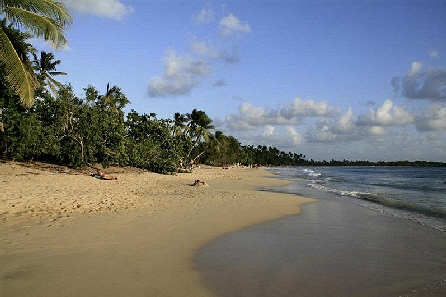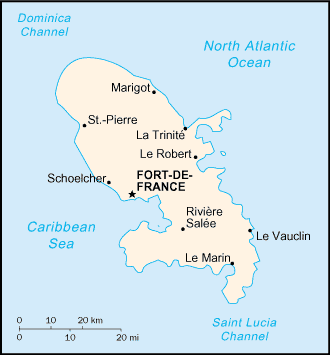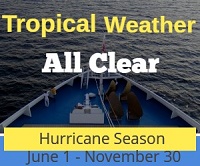Martinique Cruise Ship Destination Port
Cruise Ship Port of Call information like Port News, Weather, Transportation Options, Things to Do and See, Area Events, Medical Care, Crime and Safety Review
Venice
Get to know our slice of Paradise - located on the SW Coast of Fl.
Attractions
Beaches
Canoe/Kayak
Boat Launches
Boat Charters
Fishing Charter
Fishing Piers
Historical Sites
Golf
Parks
Hotels
Relocate
Venice Map
Southern Caribbean Port Calls
Aruba
Barbados
Bonaire
Curacao
Dominica
Grenada
Margarita Island
Martinique
Montserrat
St. Kitts
St. Lucia
St. Vincent
Trinidad
Weather
Getting Around
The roads in the French West Indies are the best in the Eastern Caribbean.
Roads are well paved and well maintained. Main roads are well marked; secondary roads and tourist sites are adequately marked. Excellent maps are available and local residents are helpful, especially if greeted in a friendly manner. Both Martinique and Guadeloupe have expressways.
Traffic safety is enforced by the police. Night driving can be dangerous, especially in the mountains and on winding rural roads.
Public transportation in the form of taxis, vans, and buses is relatively safe.
For specific information concerning French West Indies driver's permits, vehicle inspection, road tax and mandatory insurance, contact the French National Tourist Organization offices at: franceguide.com
Need to know
Natural Hazards
Hurricanes, Volcanoes, Earthquakes
Hurricanes. Martinique is situated in an area of the Caribbean prone to hurricanes. Rainy season is from May to November, and periodic hurricanes between June and November.
In the event of a tropical storm or hurricane alert, a notice will be posted on our Weather Page
Medical Services
Good medical care is available throughout the French West Indies. Not all doctors speak or understand English.
A Hyperbaric chamber is are available at: The Centre Hospitalier Universitaire in Fort de France. Website
Area Events
Matnik Caribbean Carnival
Carnival Parade with groups from Martinique and other Caribbean Islands.
Martinique Carnival
February Annual Event
Four days (fat Sunday, fat Monday, fat Tuesday and Ash Wednesday) of revelry
and celebrations.
Shrove Tuesday
Red Devils Day celebrated with a kid's parades during the day and then the adult parties in the evening. Revelers gather to mourn the end of Carnival and the symbolic death of King Carnival. Only two colors are worn: black and white.
Ash Wednesday
In a good spirit of mischief, and for as long as anyone can remember, the theme for Ash Wednesday in Martinique has been “Rejoice today, repent tomorrow.” To carry the mischief even further, about three weeks into Lent, the island comes up with a dawn-to-dusk reprise of Carnival in miniature, an official holiday known as Mi- Mi-Carême (literally “mid-Lent”). Fasting is suspended for 24 hours and the revelry starts all over again. The fete is infused, week after week, with a merry madness in the bigger towns and cities, especially Fort-de-France. In the days just preceding Ash Wednesday the celebrations reach fever pitch.
Fête de la Musique
National and International day of music with free concerts in the streets.
ports > destinations > Martinique
The islands of the Caribbean are located in a region southeast of the Gulf of Mexico and Northern America, east of Central America, and to the north of South America.
Fort-de-France Martinique
Important note:
As of January 1st, 2020, all guests on sailings visiting Martinique from and returning from the U.S will need a passport book for boarding. The passport book must be valid for at least 6 months after the sailing ends. Passport cards and birth certificates will not be accepted and may result in a denial of boarding for both adults and minors.

Les_Salines_Beach, Martinique
Good to Know
Martinique is located between the Caribbean Sea and North Atlantic Ocean, 16 miles north of St. Lucia in the Windward Islands. The Caribbean island with French flair, The Isle of Flowers, The Rum Capital of the World, The Isle of the Famed Poet (Aimé Césaire) – by any one of its many names Martinique remains one of the most alluring and enchanting destinations in the world. Martinique is an overseas region of France, and in keeping with its traditions, this vibrant island stirs the passions with awe-inspiring natural beauty, a rich cultural history, distinctive culinary delights, warm smiles and so much more. Martinique is said to have some of the prettiest terrain in all the West Indies hosting fields of flora and fauna, majestic waterfalls and rivers, hills and mountains. and pristine beaches. Two-thirds of Martinique is protected land. The highest point is Mt Pelee.
Port of Entry
Fort de France - the business center and administrative capital of the island with many tourist attractions. Most of these attractions are grouped together around the city’s haven of greenery named La Savane (Savanna.)
Official Language
French
Time Zone
AST (UTC/GMT - 4)
Map Coordinates
14°36′0N 61°5′0.02W

Average Temperatures
Water: 82° Summer - 78°
Winter Air: 82° Summer - 79° Winter
Things to do and see
Shopping
The finest French products, from Chanel fashions to Limoges porcelain, are readily available here. La Route des Rhums, a tour of the world’s finest rum distilleries based on France’s famed Route des Vins, is offered here. Look for local wares at place like Tois-llets Potery Village and Rue Victor Hugo for Creole designed gold jewelry.
Maison de la Nature
Located in Martinique’s lush central region in the town of Morne Rouge, La Maison de la Nature offers a peaceful, relaxing ecotourism experience with some of the island’s best views of Mount Pelee. Here nature lovers can enjoy 100+ species of tropical plants laid out along a hiking trail through the rainforest.
Case-Pilote
The 17th-century church in Jesuit and rococo style is the oldest on the island.
Bellefontaine
A tiny village hanging onto the cliff's edge. From the Bellefontaine beach you can watch typical fishing scenes. The fishermen here use a special type of net called a "senne."
Morne-Vert
This village not only has a very pleasant climate but also offers a magnificent view of the peaks of Carbet and Mont Pelée.
Le Carbet
There are two spots to visit in this village: the Bally distillery on the outskirts of town and the Gauguin Museum.
Fonds Saint-Denis
Clinging to the slopes of the Carbet, this enchanting little community stretches out along a winding road. Fonds Saint-Denis is dominated by the Morne-des-Cadets, where an observatory on the summit keeps constant watch on volcanic Mont Pelée.
Saint-Pierre
You cannot afford to miss this town, made famous for its near-total destruction by the eruption of Mont Pelée in 1902. The river of boiling hot lava claimed 30,000 victims. There was one survivor by the name of Cyparis, a prisoner who was protected by the thick walls of his cell. The Franck Perret Museum of Vulcanology has a collection of relics from this period that were transformed by the terrific heat.
Le Prêcheur
The last town on the northern Caribbean coast. It is famous for the hot volcanic springs and the "Tomb of the Caribbean," where according to legend a collective suicide took place when Carib Indians returned from fishing to find their village had been pillaged by the colonials. Visit the Ceron Plantation.
Le Morne-Rouge
This village stretches to the foot of Mont Pelée. For those who want to climb the majestic mountain, it is best to hire a guide. Le Morne-Rouge also is known for its pineapple jam, anthurium plantations and well-known spring waters, which are bottled here.
Ajoupa-Bouillon
This little village full of flowers is the home of an extraordinary place called "les Gorges de la Falaise," mini-gorges of the Falaise River. You can walk up the mini-gorges to a very lovely waterfall. A botanical footpath called "Les Ombrages" is a beautiful hike where you can delight in the tropical vegetation.
Basse-Pointe
Huge fields of banana and pineapple trees line the road that leads to this town situated on the Atlantic coast. It is worth making a small detour to visit the Leyritz Plantation, a colonial home built in 1700 and renovated into a hotel-restaurant in 1970.
Le Macouba
This village is built on the top of a cliff. The distillery that produces "JM Crassous de Medeuil" rum is located here.
Grand-Rivière
This small fishing village is one of the most picturesque places in Martinique. It has often been completely cut off from the rest of the island after heavy rains.
Trois-Ilets
You can get here by car of course, but also on a ferry from Fort-de-France. The Pagerie Museum is in this town, set up on the spot where Empress Josephine was born. The pottery center, where the objects are handmade by local craft artists, is also worth a visit.
Les Anses d'Arlet
This is a small fishing village with a beautiful beach frequently sought out by vacationers.
Le Diamant
This village is situated in front of the rock that shares its name, a rock that rises out of the sea 2 1/2 miles off the coast. You can admire the rock, home to many birds, from various spots nearby. The Gaoule house standing beside an old mill is also interesting for a visit.
Sainte-Luce
This is a pretty fishing village surrounded by several small beaches of white sand. You can see the rocks carved by the Carib Indians in the Montravail forest, which has been specially prepared to receive visitors.
Le Marin
The church at Le Marin, one of the most beautiful historic monuments in Martinique, was built in Jesuit style and dates back to 1766. Amateur yachtsmen know the bay as the best mooring spot on the island. A lively biennial celebration with concerts, dancing, art exhibits and food tastings takes place in Le Marin during the month of August.
Sainte-Anne
This is a pretty little region at the far southern end of the island. There are several quiet coves and capes with beautiful white sand beaches, including famous Les Salines, undoubtedly one of the most majestic beaches in all the West Indies. Beyond the Pointe des Salines, the Stony Savanna is an arid expanse of fields scattered with jasper plants and petrified wood.
Le Vauclin
This is a fishing village where visitors can find fresh fish and seafood. The return of the skiffs and fishing boats made from gum tree wood is a sight that should not be missed. A few miles from the town, at Anse Macabou, there is a beach equipped with facilities to accept visitors. Also, if you go hiking on the Montagne du Vauclin, you will be rewarded with a wonderful panoramic view.








